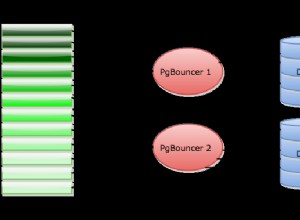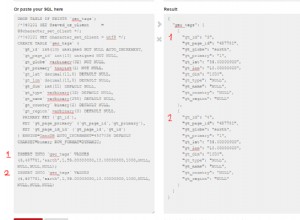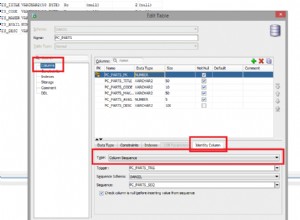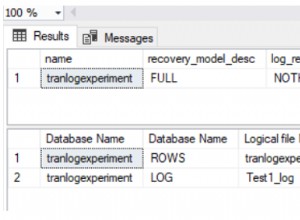Questa è una variazione del problema delle lacune e delle isole, con l'ulteriore complicazione del numero massimo di righe in ciascuna isola. Questo è un po' prolisso, ma potresti iniziare identificando i gruppi causati dall'ordine della sequenza:
select t.*,
row_number() over (partition by "Description" order by "Start") as rn,
case when lag("SequentialOrder")
over (partition by "Description" order by "Start") < "SequentialOrder"
then 1 else 0 end as newblock
from test t
order by "Start";
Start Description MaximunRow SequentialOrder RN NEWBLOCK
--------- ----------- ---------- --------------- --- ----------
12-JUN-15 A 3 3 1 0
13-JUN-15 A 3 4 2 1
14-JUN-15 A 3 5 3 1
01-JUL-15 A 3 4 4 0
02-JUL-15 A 3 3 5 0
04-JUL-15 A 3 4 6 1
01-AUG-15 B 2 5 1 0
16-AUG-15 B 2 7 2 1
È quindi possibile utilizzare un CTE ricorsivo (da 11gR2 in poi) in base a:
with u as (
select t.*,
row_number() over (partition by "Description" order by "Start") as rn,
case when lag("SequentialOrder")
over (partition by "Description" order by "Start") < "SequentialOrder"
then 1 else 0 end as newblock
from test t
),
r ("Start", "Description", "MaximunRow", "SequentialOrder", rn, blocknum,
pos, lastmaxrow) as (
select u."Start", u."Description", u."MaximunRow", u."SequentialOrder", u.rn,
1, 1, u."MaximunRow"
from u
where rn = 1
union all
select u."Start", u."Description", u."MaximunRow", u."SequentialOrder", u.rn,
case when r.pos = r.lastmaxrow or u.newblock = 0
then r.blocknum + 1 else r.blocknum end,
case when r.pos = r.lastmaxrow or u.newblock = 0
then 1 else r.pos + 1 end,
case when r.pos = r.lastmaxrow or u.newblock = 0
then r.lastmaxrow else u."MaximunRow" end
from r
join u on u."Description" = r."Description" and u.rn = r.rn + 1
)
select * from r
order by "Start";
Start Description MaximunRow SequentialOrder RN BLOCKNUM POS LASTMAXROW
--------- ----------- ---------- --------------- --- ---------- ---- ----------
12-JUN-15 A 3 3 1 1 1 3
13-JUN-15 A 3 4 2 1 2 3
14-JUN-15 A 3 5 3 1 3 3
01-JUL-15 A 3 4 4 2 1 3
02-JUL-15 A 3 3 5 3 1 3
04-JUL-15 A 3 4 6 3 2 3
01-AUG-15 B 2 5 1 1 1 2
16-AUG-15 B 2 7 2 1 2 2
Questo sta assegnando un blocknum a ciascuna riga, con quella che inizia da una per ogni descrizione nel membro di ancoraggio e viene incrementata nel membro ricorsivo se il newblock è zero (che indica un'interruzione di sequenza) o il numero di membri nel blocco è il massimo precedente. (Potrei non avere la logica per "massimo precedente" in quanto non è chiaro nella domanda.)
È quindi possibile raggruppare in base alla descrizione e al numero di blocco generato:
with u as (
select t.*,
row_number() over (partition by "Description" order by "Start") as rn,
case when lag("SequentialOrder")
over (partition by "Description" order by "Start") < "SequentialOrder"
then 1 else 0 end as newblock
from test t
),
r ("Start", "Description", "MaximunRow", "SequentialOrder", rn, blocknum,
pos, lastmaxrow) as (
select u."Start", u."Description", u."MaximunRow", u."SequentialOrder", u.rn,
1, 1, u."MaximunRow"
from u
where rn = 1
union all
select u."Start", u."Description", u."MaximunRow", u."SequentialOrder", u.rn,
case when r.pos = r.lastmaxrow or u.newblock = 0
then r.blocknum + 1 else r.blocknum end,
case when r.pos = r.lastmaxrow or u.newblock = 0
then 1 else r.pos + 1 end,
case when r.pos = r.lastmaxrow or u.newblock = 0
then r.lastmaxrow else u."MaximunRow" end
from r
join u on u."Description" = r."Description" and u.rn = r.rn + 1
)
select min(r."Start") as "Start", max(r."Start") as "End", r."Description"
from r
group by r."Description", r.blocknum
order by r."Description", r.blocknum;
Start End Description
--------- --------- -----------
12-JUN-15 14-JUN-15 A
01-JUL-15 01-JUL-15 A
02-JUL-15 04-JUL-15 A
01-AUG-15 16-AUG-15 B
I tuoi dati di esempio non attivano l'interruzione massima delle righe poiché non hai comunque sequenze più lunghe di 3. Con alcuni dati aggiuntivi:
Insert into TEST ("Start","Description","MaximunRow","SequentialOrder") values (to_date('15-JUN-15','DD-MON-RR'),'A',3,7);
Insert into TEST ("Start","Description","MaximunRow","SequentialOrder") values (to_date('16-JUN-15','DD-MON-RR'),'A',3,8);
Insert into TEST ("Start","Description","MaximunRow","SequentialOrder") values (to_date('17-JUN-15','DD-MON-RR'),'A',3,10);
Insert into TEST ("Start","Description","MaximunRow","SequentialOrder") values (to_date('18-JUN-15','DD-MON-RR'),'A',3,12);
Insert into TEST ("Start","Description","MaximunRow","SequentialOrder") values (to_date('19-JUN-15','DD-MON-RR'),'A',3,13);
la stessa query ottiene:
Start End Description
--------- --------- -----------
12-JUN-15 14-JUN-15 A
15-JUN-15 17-JUN-15 A
18-JUN-15 19-JUN-15 A
01-JUL-15 01-JUL-15 A
02-JUL-15 04-JUL-15 A
01-AUG-15 16-AUG-15 B
quindi puoi vedere che si divide al cambio di sequenza e al raggiungimento di tre righe nel blocco.
Potresti farla franca solo con il CTE ricorsivo, e non con quello intermedio precedente, confrontando l'ordine sequenziale direttamente nelle istruzioni case invece di usare newblock; ma con rn trovare la riga successiva è più facile che cercare la data successiva in quanto non sono contigue.




